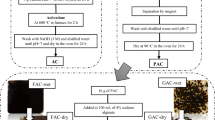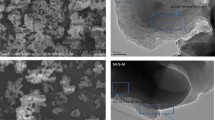Abstract
Ordered mesoporous carbon (OMC) was synthesized and used to modify the surface of a glassy carbon (GC) electrode. Due to the unique properties of OMC, a decrease in the overvoltage of the reduction potential of methyl parathion (MP) (to ca. 219 mV) and a 76-fold increase in the peak current are observed (compared with a bare GC electrode). The absorption capacity of the surface of the electrode for MP was determined by chronocoulometry. The results show that the Г value of the modified electrode (2.34 × 10–9 mol cm–2) is 9.5 times as large as that of the GC electrode (2.47 × 10–10 mol cm–2). The new electrode exhibits synergistic electrocatalytic and accumulative effects on MP. MP can be determined by linear sweep voltammetry (LSV) which displays a linear relationship between peak current and MP concentration in the range from 0.09 to 61 μM, with a detection limit as low as 7.6 nM (at an S/N of 3) and after an accumulation at 0 V for 5 min. The electrode was successfully applied to the determination of MP in spiked lake water samples.

A glassy carbon (GC) electrode modified with ordered mesoporous carbon (OMC) performed an enhanced electrocatalytic activity and accumulative effect towards methyl parathion (MP). The electrode also exhibited wider linear range, lower detection limit, better electrochemical stability and utilization for MP determination.






Similar content being viewed by others
References
Russo MV, Campanella L, Avino P (2002) Determination of organophosphorus pesticide residues in human tissues by capillary gas chromatography-negative chemical ionization mass spectrometry analysis. J Chromatogr B 780:431–441
Tan XH, Li BH, Zhan GQ, Li CY (2010) Sensitive Voltammetric Determination of Methyl Parathion Using a Carbon Paste Electrode Modified with Mesoporous Zirconia. Electroanalysis 22:151–154
Castanho GM, Vaz CMP, Machado SAS (2003) Electroanalytical procedure for the determination of methylparathion in soil suspensions and its application for sorption studies with Brazilian soils. J Braz Chem Soc 14:594–600
De Souza D, Machado SAS (2006) Study of the electrochemical behavior and sensitive detection of pesticides using microelectrodes allied to square-wave voltammetry. Electroanalysis 18:862–872
Parham H, Rahbar N (2010) Square wave voltammetric determination of methyl parathion using ZrO2-nanoparticles modified carbon paste electrode. Journal of Hazardous Materials 177:1077–1084
Sbaï M, Essis-Tome H, Gombert U (2007) Electrochemical stripping analysis of methyl-parathion (MPT) using carbon fiber microelectrodes (CFME) modified with combinations of poly-NiTSPc and Nafion films. Sensors and Actuators B 124:368–375
Zhang Y, Kang TF, Wan YW, Chen SY (2009) Gold nanoparticles-carbon nanotubes modified sensor for electrochemical determination of organophosphate pesticides. Microchim Acta 165:307–311
Zourob M, Ong KG, Zeng K, Mouffouk F (2007) A wireless magnetoelastic biosensor for the direct detection of organophosphorus pesticides. Analyst 132:338–343
Berijani S, Assadi Y, Anbia M (2006) Dispersive liquid-liquid microextraction combined with gas chromatography-flame photometric detection. Very simple, rapid and sensitive method for the determination of organophosphorus pesticides in water. J Chromatogr A 1123:1–9
Cappielo A, Famiglini G, Palma P (2003) Electron Ionization for LC/MS. Anal Chem 75:496A–503A
Lacorte S, Barceló D (1996) Determination of parts per trillion Levels of organophosphorus pesticides in groundwater by automated on-line liquid-solid extraction followed by liquid chromatography/atmospheric pressure chemical ionization mass spectrometry using positive and negative ion modes of operation. Anal Chem 68:2464–2470
Nirmala JN, Kumaravel A (2010) tearic acid modified glassy carbon electrode for electrochemical sensing of parathion and methyl parathion. J Appl Electrochem 40:1571–1574
Brett CMA (2001) Electrochemical sensors for environmental monitoring. Strategy and examples. Pure Appl Chem 73:1969–1977
Gong JM, Wang LY, Zhang LZ (2009) Electrochemical biosensing of methyl parathion pesticide based on acetylcholinesterase immobilized onto Au-polypyrrole interlaced network-like nanocomposite. Biosens Bioelectron 24:2285–2288
Shoji E, Freund MS (2001) Potentiometric sensors based on the inductive effect on the pKa of poly(aniline): A nonenzymatic glucose sensor. J Am Chem Soc 123:3383–3384
Wang J, Pumera M, Chatrathi MP (2002) Single-channel microchip for fast screening and detailed identification of nitroaromatic explosives or organophosphate nerve agents. Anal Chem 74:1187–1191
Kumaravel A, Chandrasekaran M (2010) A novel nanosilver/nafion composite electrode for electrochemical sensing of methyl parathion and parathion. Journal of Electroanalytical Chemistry 638:231–235
Du D, Ye XP, Zhang JD (2008) Cathodic electrochemical analysis of methyl parathion at bismuth-film-modified glassy carbon electrode. Electrochimica Acta 53:4478–4484
Li CY, Mo WY, Zhan GQ (2008) Sensitive Determination of Methyl-Parathion in Contaminated Water Using Single-Walled Carbon Nano-Tube Film Electrode. Chem Anal (Warsaw) 53:201–214
Ryoo R, Joo SH, Jun S (1999) Synthesis of highly ordered carbon molecular sieves via template-mediated structural transformation. J Phys Chem B 103:7743–7746
Jia NQ, Wang ZY, Yang GF (2007) Electrochemical properties of ordered mesoporous carbon and its electroanalytical application for selective determination of dopamine. Electrochem Commun 9:233–238
Liang C, Dai S (2006) Synthesis of mesoporous carbon materials via enhanced hydrogen-bonding interaction. J Am Chem Soc 128:5316–5317
Zhou M, Guo JD, Guo LP, Bai J (2008) Electrochemical Sensing Platform Based on the Highly Ordered Mesoporous Carbon-Fullerene System. Anal Chem 80:4642–4650
Jun S, Joo SH, Ryoo R, Kruk M (2000) Synthesis of new nanoporous carbon with hexagonally ordered mesostructure. J Am Chem Soc 122:10712–10713
Ndamanisha JC, Guo LP, Wang G (2008) Mesoporous carbon functionalized with ferrocenecarboxylic acid and its electrocatalytic properties. Micropor Mesopor Mater 113:114–121
Zhou M, Shang L, Li BL, Dong SJ (2008) The characteristics of highly ordered mesoporous carbons as electrode material for electrochemical sensing as compared with carbon nanotubes. Electrochem Commun 10:859–863
Li F, Song JX, Niu L (2010) Electrochemical determination of morphine at ordered mesoporous carbon modified glassy carbon electrode. Biosensors and Bioelectronics 25:1408–1413
Hou Y, Guo LP, Wang G (2008) Synthesis and electrochemical performance of ordered mesoporous carbons with different pore characteristics for electrocatalytic oxidation of hydroquinone. Journal of Electroanalytical Chemistry 617:211–217
Qi B, Lin FY, Bai J, Liu L, Guo LP (2008) An ordered mesoporous carbon/didodecyldimethylammonium bromide composite and its application in the electro-catalytic reduction of nitrobenzene. Materials Letters 62:3670–3672
Zhao D, Feng J, Huo Q, Melosh N, Fredrickson GH (1998) Triblock copolymer syntheses of mesoporous silica with periodic 50 to 300 angstrom pores. Science 279:548–552
Liu GD, Lin YH (2005) Electrochemical Sensor for Organophosphate Pesticides and Nerve Agents Using Zirconia Nanoparticles as Selective Sorbents. Anal Chem 77:5894–5901
Holbrey JD, López-Martin I, Rothenberg G (2008) Desulfurisation of oils using ionic liquids: Selection of cationic and anionic components to enhance extraction efficiency. Green Chemistry 10:87–92
Zhang Z, Wang E (2000) Electrochemical Principles and Methods. Science Press, Beijing
Vieira DC, Fatibillo-Filho O, Angnes L (1999) Zucchini crude extract palladium modified carbon paste electrode for the determination of hydroquinone in photographic developers. Anal Chim Acta 398:145–151
Wang B, Cao X (1991) Anodic oxidation of hydrazine on glassy carbon modified by macrocyclic transition metal complexes: part 1. Cobalt protoporphyrin dimethyl ester modified electrode. J Electroanal Chem 309:147–158
Laviron E (1979) General expression of the linear potential sweep voltammogram in the case of diffusionless electrochemical systems. J Electroanal Chem 101:19–28
Kang TF, Wang F, Lu LP (2010) Methyl parathion sensors based on gold nanoparticles and Nafion film modified glassy carbon electrodes. Sensors and Actuators B 145:104–109
Acknowledgements
The authors gratefully acknowledge the financial support by the National Natural Science Foundation of China (No. 20875012).
Author information
Authors and Affiliations
Corresponding author
Electronic supplementary materials
Below is the link to the electronic supplementary material.
Table S1
Comparison of linear range, detection limit of MP at different electrodes (DOC 33 kb)
Fig. S1
(a) The relationship between the peak currents and scan rates ranging from 10 to 130 mV·s–1. (b) The relationship between the peak currents and the square root of scan rates ranging from 140 to 600 mV·s–1 (DOC 55 kb)
Fig. S2
The plots of the peak potential E pa versus solution (0.1M phosphate buffer solution) pH. Scan rate: 100 mV·s–1. Inset figure shows the comparison of three different types of buffer solutions: phosphate buffer solution (a), acetate buffer solution (b) and B-R buffer solution (c) (DOC 43 kb)
Fig. S3
The effect of accumulation time on the peak current intensity of MP voltammograms (0.1 M phosphate buffer solution pH 6.0, other variables are same as those in Fig. 2) (DOC 37 kb)
Rights and permissions
About this article
Cite this article
Pan, D., Ma, S., Bo, X. et al. Electrochemical behavior of methyl parathion and its sensitive determination at a glassy carbon electrode modified with ordered mesoporous carbon. Microchim Acta 173, 215–221 (2011). https://doi.org/10.1007/s00604-011-0551-1
Received:
Accepted:
Published:
Issue Date:
DOI: https://doi.org/10.1007/s00604-011-0551-1




